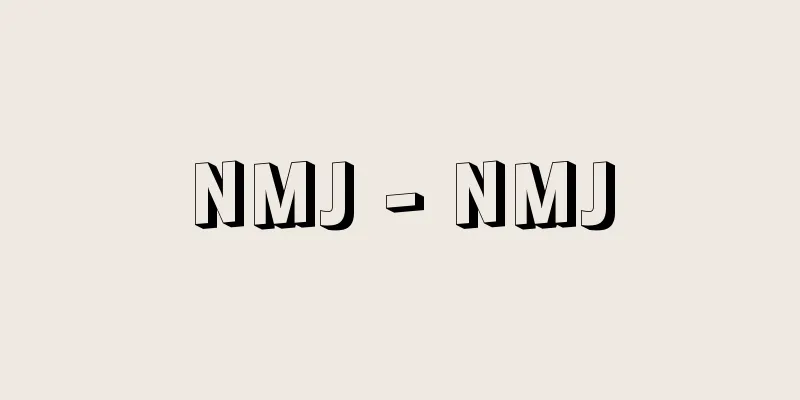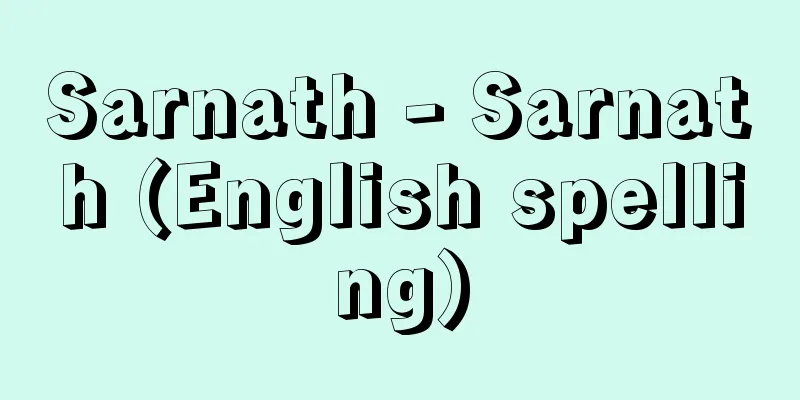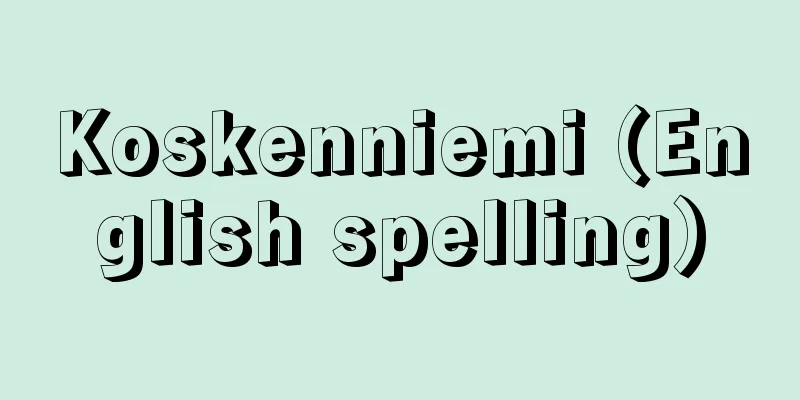Nazis - Nachisu (English spelling)

|
The nickname for the National Socialist German Workers' Party, Nationalsozialistische Deutsche Arbeiterpartei. Its abbreviation is NSDAP. Nazi (singular and adjective) or Nazis (plural) is a derogatory term given to the party by German political opponents and anti-Hitler factions in the West. In Japan, the official abbreviation was Nazism, whether in the singular or plural. Today, Nazism and Nazism are used worldwide, while in Germany NS (NS) is used instead. The Nazis were the most thoroughgoing fascist party, and Nazi rule lasted from 1933 to 1945, known as the Third Reich. The spirit and beliefs of the Nazi Party, or its ruling system, are also known as Nazism. [Murase Okio] The Nazi characterThe Nazis were based on ideas and movements such as anti-Semitism, white supremacy, and imperialism that were widespread in Europe at the end of the 19th century, as well as the anti-socialism and anti-democracy of the middle class that was suffering between capitalist society and the socialist movement, but at the same time they were also based on ideas and movements that were unique to Germany, namely the movement that sought to save the middle class that was declining due to rapid industrialization, nationalism that had even infiltrated the labor movement, and the contradictory ideas and movements such as militarism, bureaucracy, authoritarianism, anti-Westernism, and German national supremacy that were common to the military and bureaucrats under the Second Reich, as well as to all levels of the private sector. One of the central theories of the Nazis is the theory of race. The German people, being the strong ones, must conquer various parts of Europe and obtain a vast living space. The weaker Slavic peoples are destined to be dominated by the German people, and "inferior races" such as the Jews have no choice but to be isolated or exterminated. A superior race must not taint its superior blood by marrying an inferior race. The Nazis preached that the German people, as members of the ethnic community, must work together in unity to develop the nation, and that to do so, a dictatorship based on the "leadership principle" of following orders from above and being responsible to those below, was necessary. However, within the party there were factions that advocated the supremacy of agriculture, the supremacy of modern technology, bureaucratic conservatives, socialist laborers, and others, each of which put forward different demands, and many of the party members were careerist opportunists who acted according to their everyday interests. [Murase Okio] Characteristics of the Nazi MovementThe Nazis maintained the characteristics of Germany since the Second Reich, while insisting on bold modernization and reform within the country. In other words, they demanded the protection of craftsmen, small merchants, and small farmers, the abolition of old morals and customs, the improvement of the lives of the lower middle class and the large-scale promotion of capable people from this class, and the expansion and improvement of social and welfare policies. Their supporters included the urban and rural middle class who were living unfortunate lives in an advanced industrial society, as well as workers and the unemployed who were dissatisfied with labor unions. The big capitalist class and the military shared the same goals as the Nazis (elimination of class struggle, reestablishment of militaristic order, overthrow of democratic republics, economic development, large-scale expansion of the military, and German domination of Europe), so there were many who actively supported the Nazis. However, those who supported the conservative imperialists and kept their distance from the Nazis formed the majority of the ruling forces. The Nazis actively involved lower middle-class men and women, as well as boys and women in rural areas, in their movement, took a rebellious stance against the corrupt established society, and tried to protect and improve the lives of the people. However, the movement's policy was not uniform across the country, and in Protestant rural areas, the majority of their supporters were middle- to large-scale farmers, while in Catholic areas, the majority of their supporters were poor farmers and agricultural workers. [Murase Okio] Party DevelopmentThe party's predecessor was the German Workers' Party, Deutsche Arbeiterpartei, which was founded in Munich on January 5, 1919. It was an extreme right-wing party based on the Thule Gesellschaft, the Bavarian local organization of a national extreme right-wing anti-Semitic group, and aimed to promote anti-Semitism and the salvation of the working and middle classes. In response to the German Revolution of November 1918, the party became active when the counter-revolution in Bavaria succeeded in May 1919, and the movement developed through mass activities after Hitler joined the party in mid-September of the same year. On February 24, 1920, the party published a 25-point party platform (Twenty-Five Points Platform), and around this time the party name was changed to National Socialist German Workers' Party. However, a dispute arose between Hitler and the former executives over the organization and management of the party, and an extraordinary party conference was held on July 29, 1921, at which Hitler established his dictatorial position. Dietrich Eckart (1868-1923), a right-wing critic and artist who was the editor-in-chief of the party's newspaper, the Völkischer Beobachter, linked Bavarian upper class, intellectuals and conservatives to Hitler. Röhm, a staff officer in the Bavarian military, also supported Hitler from within the military. Julius Streicher (1885-1946), a leader of the anti-capitalist, anti-Semitic movement in Franconia in northern Bavaria, and others also joined in October 1922. The movement thus developed widely throughout Bavaria, centered in Munich, and was successful in persuading various segments of the middle class, who were struggling to make ends meet, against the Treaty of Versailles, against the Jews and against the Weimar Republic. The support of the big capitalists was also strengthened. In January 1923, the French army forced its occupation of the Ruhr, and inflation progressed at a ferocious pace, causing the people's lives to collapse. The party participated in a movement to establish a right-wing dictatorship by the military, big capitalists, and far-right politicians, and staged a putsch (Hitler Putsch) in Munich on November 8-9, 1923. However, the putsch failed because it did not receive support from the core of the military, police, and bureaucracy. The party was temporarily banned, but was re-established on February 27, 1925, after Hitler was released from prison. [Murase Okio] From rebuilding the party to becoming the leading partyAfter his release from prison, Hitler published Mein Kampf (1925-26) to set out his movement policy, and while maintaining legalism, he developed mass organizations and adopted a strategy of occupying democratic states from within. In addition to the SA (Storm Troops), the Hitler Youth and the Nazi Student League were organized, and a unified organization of business cells was formed to attract workers to party members. However, workers were not assimilated into the Nazis even after the Nazi regime was established. In northern Germany, mainly in the Rhine region, the left wing of the party developed around Strasser, calling for the distribution of land to farmers, the nationalization of important industries and the distribution of the profits to employees. However, at the Bamberg Party Conference in February 1926, Hitler's leadership was established, and the left wing debater Goebbels came to support Hitler, and in November of the same year, he began propaganda and organizational activities as the leader of the capital Berlin, where Marxist forces were dominant. The strong party organization in Berlin was seen as a model for the movement, but the party's influence was sluggish nationwide. At the end of 1927, the movement changed direction and focused its propaganda on the middle class. As a result, the party's support among the middle class gradually increased. For example, in the general election of September 1930, the party won 35.1% of the support in the rural areas of Schleswig-Holstein, and in the general election of July 1932, this number increased to 63.8%. The party's influence also increased in urban areas throughout the country, and while the Social Democrats and Communists maintained a majority in the Berlin City Council, the Nazis tripled their votes in each election in the city for three years from 1928. In the general election of July 1932, they won 37.4% of the votes, far surpassing the other parties and becoming the largest party. The number of party members was just over 100,000 at the end of 1928, but by the beginning of 1933 it had reached 1.5 million. Thus, the conservative imperialists, military, and central business leaders around President Hindenburg decided to form a coalition cabinet centered on the Nazis, and on January 30, 1933, Hitler was appointed Chancellor. [Murase Okio] Party OrganizationAs the party's organization expanded, its structure became more complex. After the establishment of the government, the organization was roughly as follows: "blocks" were created for every 160 to 240 people (40 to 60 households), and "cells" were placed in districts with 4 to 8 blocks. The size of the blocks was limited to a scale that allowed the party to have a sufficient grasp of each household. A leader was placed in each block and cell, and district branches were placed above the cells. According to the 1937 regulations, the size of a district branch was limited to a maximum of 3,000 households (halved to 1,500 in 1938), with a maximum of 500 party members, and was placed in each village municipality as much as possible. The party's lower organizations were generally weak, and in many cases there were only two or three block leaders under the district branch leader. Positions below the district branch leader were unpaid honorary positions, so there were no full-time secretaries, and the implementation of party directives was extremely inadequate. Above the district branches were county branches, whose leaders (heads) were full-time paid employees, and party organizations at the county level and above were strong. Above the county were districts, and there were 32 district leaders nationwide until the end of 1937, and 41 after 1939. Supported by many staff members, they wielded great power. The Führer's Deputy Staff was in charge of the party organizations nationwide, and various party organizations were also controlled by this department. The party's constituent organizations (organizations within the party) were the SS (Schutzstaffel), SA (Storm Troops), Nazi Women's League, Hitler Youth, German Virgins' League, Nazi Student League, Nazi University Lecturers' League, and Nazi Motorists' League, and the party's affiliated organizations (formally independent) were the German Labor Front, Nazi Teachers' League, Nazi Lawyers' League, Nazi Doctors' League, Nazi People's Welfare Organization, National League of German Civil Servants, Nazi German Engineers' League, and Nazi War Victims' Protection League. [Murase Okio] The Construction of the Third ReichAfter forming his government in January 1933, Hitler dissolved the German Reichstag and used the Reichstag arson incident to crack down on opponents, winning the general election in March of the same year. He allied with the conservative imperialists to control parliament, and mobilized various mass groups, including the SA, to carry out street marches, arrests of opponents, and attacks on opposition organizations nationwide to solidify the foundations of his power. On March 23 of the same year, he passed the Enabling Act in parliament and established a dictatorship. He also abolished labor unions on May 2 and reorganized workers into the German Labor Front. On July 14, the formation of all new political parties was banned, and the sole rule of the Nazi Party was established. In addition to securing the overwhelming support of the ruling forces, the number of people joining the party increased dramatically in search of job stability and promotion, and by the beginning of 1935, two-thirds of the party members had been new members after the party came to power. Meanwhile, the SA, which had supported the Nazi movement while it was out of power, had many of its leaders massacred between the end of June and the beginning of July 1934 (the Röhm Affair) due to its independent and aggressive nature, and the conservative faction of the Nazi Party gained full power, allying with the conservative imperialist faction and promoting the bureaucratization and militarization of the country. The SS, which was originally an organization within the SA, became an independent organization after the Röhm Affair, and its Secret State Police (Gestapo) arrested and detained political opponents without legal procedures, and imprisoned dangerous or anti-social people in concentration camps where they abused them. After Hindenburg's death on August 2, 1934, Hitler became Führer (meaning leader, combining the positions of president and chancellor; translated as Führer). The Wehrmacht had been expanded fivefold since the introduction of general compulsory military service in March 1935, and as young officers and NCOs were promoted rapidly, the number of Hitler admirers among the officers increased, which put them at odds with the senior officers who maintained the traditions of the Prussian military. The Navy, which was also greatly expanded, and the newly established Air Force, attracted many more Nazi sympathizers. Agriculture, commerce, industry, and other commercial sectors were forcibly organized into their respective professional associations and operated under the guidance and supervision of the state. Cities also lost their autonomy, with mayors, deputies, and councilors appointed by the party and the state, newspapers and the entire culture were controlled by Goebbels' Ministry of Propaganda and Enlightenment, artists were organized into the German National Cultural Institute, and university rectors were appointed by the state. Each government office and control body was organized according to the "Leader Principle," and it seemed as if the whole of Germany had been reorganized into a suffocating dictatorship. However, because of the intense conflict and competition between the Nazi government offices and the control agencies, each side tried to crush the other's claims, which became common sense in the real politics of the Third Reich. In the Third Reich, Hitler's orders were supposed to be carried out unconditionally, but in reality, traditional political, social, and cultural pressure groups and political forces all insisted on their own interests, so traditional society was maintained and modernization was carried out within that framework only when necessary. Because the lower party organizations were weak, Hitler's orders often could not be carried out at the district level if they conflicted with the interests of the traditional ruling forces. [Murase Okio] Economic DevelopmentFirst, the unemployment relief program that had been in place since the end of the Weimar Republic was greatly expanded, with the construction of roads, land improvement works, airfields, and barracks proceeding. In June 1935, a six-month compulsory labor service system was introduced for young men (and partly women), and in August the following year, one-year military service was extended to two years. Various control organizations and government agencies also expanded, so the number of unemployed people, which had exceeded six million in early 1933, fell to 2.97 million in January 1935 and to 300,000 in January 1939, and many industries were acutely aware of the labor shortage. Schacht, president of the Reichsbank (German national bank), also served as Minister of Economics. To avoid inflation, he froze wages and prices, increased taxes on corporate profits, and promoted large-scale economic construction. The defense budget grew far more than other fiscal expenditures (600 million marks in 1932, 3.3 billion marks in 1934, and 10.9 billion marks in 1937). Schacht resigned in opposition to the rapid expansion of the military, and Walter Funk (1890-1960), chairman of the Economic Policy Committee of the Nazi Party, became Minister of Economics in his place. In commerce, Germany made barter agreements with the Balkan countries, incorporating the region into its economic sphere of influence. In addition, the country acquired foreign currency through dumping, which was used to purchase necessities. In industry, the production of iron and coal was increased, and the value of iron ore production increased sixfold in six years, and the value of coal production also increased dramatically. The government, ignoring profitability, forced the refinement of inferior raw ore, and the state-run Hermann Goering Factory was established, which became Germany's largest industrial company. The production of synthetic rubber and artificial oil by liquefying coal also progressed. In the heavy industry, there were those who supported and those who opposed the Nazi Party's war policy, but the chemical industry was dominated by those in favor of the war. In order to maintain the popularity of the people, the Nazis placed importance on consumer life, and also focused on durable consumer goods and housing construction. In addition, the Nazis favored large companies and respected their management autonomy, so they prospered and continued to have great power despite various state controls. As rearmament progressed, a state of full employment emerged and the labor shortage became keenly felt, leading to an improvement in the income and social status of workers. The people supported the Nazis mainly because of the improvement in their standard of living. In agriculture, agricultural producers' associations were organized, which controlled the sale of agricultural products, controlled the market, and determined prices, stabilizing agricultural product prices. The German Labor Front, as a labor-management cooperation organization, could not ignore the strong traditions of the labor movement, and often played a labor union role in conflict with capitalists. The Labor Front's "joy march" (Kraft durch Freude) attracted attention for its contributions to improving workers' leisure time and quality of life. [Murase Okio] Control and everyday lifeThe Nazis fixed the wages of workers and issued them with work handbooks in February 1935, making it extremely difficult for them to change jobs, but when the labor force became insufficient and each industry competed to poach workers illegally, workers won permission to change jobs by sabotaging, small-scale strikes, and faking illness. They also reduced work efficiency and increased wages to protect their livelihood. Agricultural workers and servants were also prohibited from changing jobs to industry, but they accepted invitations from the industry and made illegal changes, and their wages skyrocketed because of the extreme shortage of agricultural labor. In terms of cultural life, in May 1933, "objectionable" books were burned in the streets of German university towns by the Nazi Student League under the direction of the Ministry of Propaganda and Enlightenment, and these books were removed from public libraries. Although many authors had been banned and many intellectuals fled the country, bookstores continued to sell the books that had been burned in the streets, and conscientious research and artistic works by non-Nazi intellectuals were widely read. Foreign literary books and publications were imported and translated, as long as they did not directly attack the Nazis. As for music, jazz was suppressed as being black, but it was often played at public concerts, cafes, and dance halls, and the fast-paced swing music was particularly popular, and people danced wildly to the music. As for movies, the government-promoted Nazi films were not well received, and American movies were always packed. The Hitler Youth was given the exclusive right to control the education and training of young people by law, but in March 1939 it became a compulsory organization for all young men and women between the ages of 10 and 18. Young men and women disliked the various volunteer activities and military training offered by the Hitler Youth and often refused to be mobilized, instead meeting in free groups, dressing as they pleased, having fun, and traveling wherever they pleased. In general, the mutual competition and conflict between the various control agencies and authorities resulted in the remaining areas of freedom from control in various areas of the Third Reich. [Murase Okio] Foreign Policy and the Nation in WartimeIn the early years of the Third Reich, the policy of diplomacy was to avoid war while strengthening the nation's power and improving its international status. International conflicts were also skillfully used. In October 1933, Germany withdrew from the League of Nations because it did not recognize the right to equality in arms. In March 1935, in violation of the provisions of the Treaty of Versailles, general conscription was adopted and the army was expanded five-fold in one go, and in June of the same year, the navy was expanded four-fold through the Anglo-German Naval Agreement. In March 1936, Germany abolished the Locarno Treaty, invaded the Rhineland demilitarized zone, and turned the German-French border into a fortress. The Berlin Olympics held in August of the same year became an opportunity to demonstrate Germany's national power both at home and abroad. Germany's support for the Franco army (rebel forces) during the Spanish Civil War brought Germany closer to Italy, and the German-Italian Treaty was concluded on October 25, 1936, forming the Berlin-Rome Axis. The Anti-Comintern Pact with Japan on November 25 of the same year further strengthened Germany's position against Britain and France. In February 1938, moderates within the ruling powers were dismissed, making Germany's hardline diplomatic stance clear. On March 13, 1938, Germany occupied and annexed Austria militarily (Anschluss). It then annexed the Sudetenland, an ethnic German region of Czechoslovakia, in September of the same year under the Munich Agreement, and Germany's national power became overwhelming throughout Europe. In March 1939, on the pretext of an independence movement by the Slovak people, Germany occupied the Czech region and made it a German protectorate, and granted independence to Slovakia, making it a German protectorate. It then demanded the return of the Polish Corridor and Danzig (Gdansk) to Germany, formed a military alliance with Italy on May 22, and signed the German-Soviet Non-Aggression Pact on August 23, giving it a strategically advantageous position, before invading Poland on September 1 and sparking World War II. On September 27, 1940, Germany signed the Tripartite Pact with Japan, Germany, and Italy, and on June 22, 1941, Germany invaded the Soviet Union, starting the German-Soviet War. After Germany was finally defeated, Hitler committed suicide on April 30, 1945. On May 8, the entire German army surrendered unconditionally, and peace was restored to Europe on May 9. Rationing of goods was relatively common in daily life during the war, so people did not suffer from scarcity as they had during World War I. In the early days, the people were intoxicated with a sense of victory, but this did not last and they soon sought peace. However, at the Casablanca Conference in January 1943, the United States and Britain demanded Germany's unconditional surrender, and air raids on Germany, especially indiscriminate bombing, intensified from the summer of that year. As a result, people began to view the Nazi regime and the German state as one and the same, and the resistance movement was not very active. Spontaneous acts of rebellion among young people and workers grew stronger, and the authority of the government weakened, but Hitler worship remained among the people and helped maintain the regime. During the war, to make up for the labor shortage, 12 million foreign male and female laborers and prisoners of war were forced to work in the country's munitions factories and farms. However, the working conditions for the Eastern European laborers and prisoners of war were so poor that the death rate was high, and only 7.5 million of the total foreign laborers and prisoners of war survived until the end of the war. [Murase Okio] Persecution and massacre of the JewsIn 1910, there were over 610,000 Jews in Germany, but by 1933, this number had decreased to just over 500,000. Although they were Jewish, they had assimilated into German culture and were patriotic German citizens. Germans have long had discriminatory feelings toward Jews, but anti-Semitic propaganda was not popular among the general public. In April 1933, the Nazis organized a boycott of Jewish stores, and in the same month, the Law for the Reconstruction of the Civil Service expelled Jews from public office. On September 15, 1935, the Nuremberg Laws were issued, banning marriage with Jews, and from the night of November 9 to the early morning of the 10th, 1938, the SA raided Jewish neighborhoods and churches (Kristallnacht). After this, all Jewish stores were closed and Jewish people were banned from theaters and other places, so they had no way to survive other than working as forced laborers. Many Jews rushed to leave the country, even though their property was confiscated, and by 1939 their numbers had decreased to 215,000. When World War II began, the persecution and massacre of Jews in territories occupied by the German army began, and at the Wannsee (now Berlin) Conference on January 20, 1942, a "policy of extermination" was decided and implemented, whereby all European Jews were transported to Eastern Europe, where they were forced to do labor and die as many as possible, with the sick and weak being killed in gas chambers from the start. It is estimated that around 4.5 million people were killed. This policy was implemented because, as a result of the German-Soviet War, it became impossible to deport the Jews to places outside of Europe, and a wide range of military and occupied territory bureaucrats supported and carried out this policy. [Murase Okio] History of research on the NazisDuring the Third Reich, there were many studies glorifying the Nazis in Germany and the West, but there were also studies by refugees and modern political scientists in the West that portrayed the Nazis as an abnormal phenomenon in modern society. F. Neumann's Behemoth (1942) (translated by Tomotaka Okamoto, Eisuke Ono, and Eiichi Kato, 1963, Misuzu Shobo) is still read today, and this school of thought portrays the Third Reich as a "crazy" dictatorship in which Hitler and the Nazi Party wielded unlimited power. Even after the war, researchers of this school defended democracy and described the German people as robots who were manipulated by the powerful Nazi propaganda, and the hellish and miserable lives of the people. A. Bloch's Hitler: A Study of Tyranny (1952) (translated by Onishi Tadaaki as Adolf Hitler, 2 volumes, 1958-60, Misuzu Shobo) is also a laborious work based on a huge amount of historical material, but it takes a similar view of the Nazis. In the 1950s, second-ranking officials of the Nazi regime regained their freedom and wrote memoirs, including self-defense, in which they placed all the responsibility for the war and war crimes on Hitler and the top Nazi officials, but in these memoirs they also made clear the differences in opinions and positions between the various leaders. Schacht's My 76 Years of Life (1953) (translated by Nagakawa Hideo as My Life, 2 volumes, 1954, Keizai Hihisha) is a representative example. It was not until 1960 that the actual state of the Third Reich began to be objectively examined as various historical documents were made public. F. Fischer examined Nazism in the context of the continuity of war aims and ruling powers from the Second Reich through the Weimar Republic to the Third Reich, and his student Bent's Munich (1965) reviewed the British appeasement policy from the perspective of the clash between British and German imperialist policies. Fischer's The Alliance of the Elites (1979) explored the continuity of ruling powers up to 1945 in more detail. Fischer pointed out that the negative tradition of German history gave birth to the Nazi regime, but the majority of German academics and intellectuals refuted, saying that the Second Reich had nothing in common with the Nazi regime and that the Nazis were a mutation of German history. During this time, the publication of Schonbaum's Hitler's Social Revolution (1966) (translated by Oshima Michiyoshi and Kaori, 1978, Jitsuryo Shobo) provided a deeper understanding of the progress of modernization in the Third Reich and the continuity and discontinuity of its ruling powers, and it became clear that various political and social forces existed and fought within the Third Reich. In this way, the movements of the Third Reich came to be understood from the conflicts and compromises of the various ruling powers, and Michalka's Ribbentrop and Germany's World Policy (1980) clarified the pluralistic ruling structure in foreign policy decisions. Furthermore, the great discrepancy between the pretense and reality under Nazi rule began to attract attention, and various surveys of the situation revealed the continuity and change in the daily lives of the German people, the people's shrewd lifestyle, and the limits of the Nazi Party's ruling power. Bavaria in the Nazi Era, edited by Broszat et al., 6 volumes (1977-83), is a valuable collection of historical documents, while Schäfer's Divided Consciousness: The Reality of German Culture and Life, 1933-45 (3rd edition, 1983) and Peukert's Ethnic Compatriots and Enemies of the Community: Conformity, Exclusion, and Rebellion under Nazi Rule (1982) shed light on the lives of the people who survived under Nazi dictatorship and the weakness of Nazi control. [Murase Okio] "German Dictatorship, by Blacher, translated by Yamaguchi Sadamu and Takahashi Susumu, 2 volumes (1975, Iwanami Shoten)" ▽ "Hitler's Social Revolution, by Schonbaum, translated by Oshima Michiyoshi and Kaori (1978, Jitsuryo Shobo)" ▽ "Nemesis of Power: The Wehrmacht and Hitler, by Wheeler Bennett, translated by Yamaguchi Sadamu (1984, Misuzu Shobo)" ▽ "Nazism, by Murase Okio (Chuko Shinsho)" ▽ "Inside Story of Nazi Madness, by Speer, translated by Shinada Toyoji (1970, Yomiuri Shimbun)" ▽ "Life of the Common People under Nazi Rule, by Murase Okio (1983, University of Tokyo Press)" [References] | | | | | | | | | | | | | | [Additional information] |Source: Shogakukan Encyclopedia Nipponica About Encyclopedia Nipponica Information | Legend |
|
国民社会主義ドイツ労働者党Nationalsozialistische Deutsche Arbeiterparteiの通称。略称はNSDAP。ナチNazi(単数および形容詞)またはナチス(複数)は、ドイツの政敵や欧米の反ヒトラー派がこの党に与えた卑称である。日本では公式の略称としては単数、複数を問わずナチスとよんでいた。今日では世界的通称としてナチおよびナチスが使用され、ドイツではそのかわりにNS(エヌエス)が使用される。ナチスはもっとも徹底したファシスト政党で、ナチス支配は1933年から45年まで行われて、第三帝国と称せられる。ナチス党の精神と主張あるいはその支配体制をナチズムとも称する。 [村瀬興雄] ナチスの性格ナチスは、19世紀末のヨーロッパに広まっていた反ユダヤ主義、白色人種至上主義、帝国主義、さらに資本主義社会と社会主義運動との間にあって苦しむ中産階級の反社会主義・反民主主義などの思想と運動を基礎としていたが、同時にドイツ特有の思想と運動にも立脚している。すなわち、急激な工業化のために没落しつつある中間層の救済を求める運動、労働運動のなかにまで侵入した国家主義、あるいは、第二帝政下の軍部・官僚、さらに民間各層に共通する軍国主義・官僚主義・権威主義・反西欧主義・ドイツ民族至上主義などの矛盾した思想と運動がそれである。 ナチスの中心理論の一つは人種論である。強者であるドイツ民族はヨーロッパ各地を征服して、広大な生存圏を獲得しなければならない。弱者であるスラブ民族はドイツ民族に支配される運命にあり、ユダヤ人などの「劣等民族」は、隔離するか絶滅するほかない。優秀な民族は、劣等な民族と結婚して自分の優秀な血液を濁してはならない。ドイツ民族は、民族共同体の一員として、一致団結して民族の発展に努めなければならず、上部の命令に従い、下部に対しては責任をもつという「指導者原理」による独裁政治がそのために必要となる、とナチスは説いた。しかし、党内部には農業至上派、近代技術至上派、官僚的保守派、社会主義的労働者派などがあって、それぞれ別々な要求を提出しており、党員の多くは日常の利害関係に従って行動する出世主義的な日和見(ひよりみ)主義者であった。 [村瀬興雄] ナチス運動の特色ナチスは第二帝政以来のドイツの特色を維持しつつ、その内部で大胆な近代化と改革とを行うことを主張した。すなわち、手工業者・小商工業者・中小農民の保護、旧道徳や習慣の廃止、下層中産階級の生活向上とこの層の有能な人物の大規模な登用、社会政策と福祉政策の拡張充実などを要求していた。その支持者には、高度工業社会で不遇な生活をしている都市と農村の中産階級や、労働組合に飽き足りない労働者、失業者までが含まれていた。大資本家層と軍部などは、ナチスと共通の目標(階級闘争の排除、軍国主義的秩序の再建、民主共和制の転覆、経済の発展、軍備の大拡張、ドイツのヨーロッパ制覇)をもっていたので、積極的にナチスを支持する者が少なくなかった。しかし、保守帝政派を支持しナチスには距離を置く者のほうが支配勢力の主流をなしていた。 ナチスは、下層中産階級の男女、農村の少年や婦人を積極的に運動に巻き込み、腐敗した既成社会に反逆する態度をとり、民衆の生活を保護し向上させることに努めた。しかし全国的に画一的な運動方針がとられたわけではなく、プロテスタント農村では中農から大農の支持者が多く、カトリック地帯では貧農や農業労働者の支持者が多かった。 [村瀬興雄] 党の発展党の前身は、1919年1月5日ミュンヘンで結成されたドイツ労働者党Deutsche Arbeiterparteiである。これは、全国的な極右反ユダヤ団体のバイエルン地方組織であるトゥーレ協会Thule Gesellschaftを基礎とし、反ユダヤ主義と、労働者および中産階級の救済とを目的とする極右政党であった。1918年11月のドイツ革命に対し、19年5月バイエルンで反革命が成功すると、党は活発な活動を始め、同年9月中旬にヒトラーが入党して以来、大衆活動によって運動は発展を遂げた。20年2月24日、25か条からなる党綱領(二十五か条綱領)を公布し、このころから党名を国民社会主義ドイツ労働者党と改称した。だが、ヒトラーと旧幹部との間に、党の組織と運営をめぐって争いが起こり、21年7月29日に臨時党大会が開かれて、ヒトラーの独裁的な地位が確立した。党機関紙『フェルキッシャー・ベオバハター』の主筆で右翼評論家かつ芸術家のエッカートDietrich Eckart(1868―1923)は、バイエルンの上流社会、知識人、保守派をヒトラーに結び付けた。またバイエルン軍部の参謀レームも軍部の内部からヒトラーを支持した。バイエルン北部のフランケン地方の反資本主義的反ユダヤ運動の指導者シュトライヒャーJulius Streicher(1885―1946)らも22年10月に合流した。こうして運動はミュンヘンを中心としながらバイエルン各地で大発展を遂げ、生活難に苦しむ中産階級各層に対してベルサイユ条約反対、ユダヤ人反対、ワイマール共和制反対を説いて成功を収めた。大資本家の支持も強化された。23年1月フランス軍のルール占領が強行され、インフレーションが猛烈な勢いで進行すると国民生活が破綻(はたん)した。党は軍部、大資本家、極右政治家による右翼独裁の樹立運動に参加して、23年11月8~9日、ミュンヘンで一揆(いっき)(ヒトラー一揆)を起こした。しかし軍部、警察、官僚の中枢部の支持が得られなかったので、一揆は失敗した。党は一時禁止されたが、ヒトラーが出獄したあと、25年2月27日に再建された。 [村瀬興雄] 党の再建から第一党へ出獄後のヒトラーは、『わが闘争』Mein Kampf(1925~26)を出版して運動方針を示し、合法主義を守りながら大衆組織を発達させて、民主主義国家を内部から占領する戦略をとった。SA(エスアー)(突撃隊)のほかにヒトラー・ユーゲント、ナチス学生同盟が組織され、また党員による労働者獲得のために、経営細胞の統一組織が組織された。しかし労働者は、ナチス政権の成立後になってもナチスには同化されなかった。ライン地方を中心とした北ドイツ各地で、農民への土地分配、重要産業の公有化とその利益の使用人への分配などを主張する党内左派が、シュトラッサーを中心として発展した。しかし1926年2月のバンベルク党会議においてヒトラーの指導権が確立し、左派の論客ゲッベルスがヒトラー支持に回り、同年11月から、マルクス主義勢力の優勢な首都ベルリンの大管区指導者として、宣伝と組織活動を開始した。ベルリンの強力な党組織は運動の模範とされたが、党勢は全国的には伸び悩んだ。27年末に運動の方向転換を行い、宣伝の焦点を中産階級へと絞った。そのため、中間層の支持者がしだいに増加してきた。たとえば、30年9月の総選挙で党はシュレスウィヒ・ホルシュタイン州農村部で35.1%の支持を獲得、さらに32年7月の総選挙では63.8%に増加している。全国の都市部をみても党勢は増し、ベルリン市会では社会民主党・共産党による過半数が維持されていたが、ナチスは同市において28年から3年間、選挙ごとにその得票を毎年3倍ずつ増大させた。そして、32年7月の総選挙では37.4%の票を集め、他を引き離して第一党となった。党員数も28年末に10万人余りであったが、33年初めには150万人に達した。かくて、大統領ヒンデンブルク周辺の保守帝政派、軍部、経済界中枢部は、ナチスを中心とする連立内閣の樹立に踏み切り、33年1月30日、ヒトラーは首相に任命された。 [村瀬興雄] 党の組織党の組織が膨張するにつれて、その構成も複雑となった。政権確立後の組織は、だいたい次のごとくである。人口160人から240人(世帯数40~60)ごとに「ブロック」をつくり、4~8ブロックをもつ地区に「細胞」を置いた。ブロックの大きさは、党が各世帯を十分に把握できる規模にとどめた。ブロックと細胞にそれぞれ指導者が置かれ、細胞の上に地区支部が置かれた。地区支部の規模は、1937年の規定によれば、最高3000世帯(38年には1500世帯と半減)、党員は500人を限度として、できるだけ村落自治体ごとに置かれた。党の下級組織は概して弱体で、地区支部指導者の下に2、3人のブロック指導者がいるだけの場合が多かった。地区支部指導者以下の地位は無給の名誉職であったから、そこには専従事務員もいなかったし、党の指令の遂行もきわめて不十分なものとなった。地区支部の上に郡支部があり、その指導者(長)は有給専任職で、郡以上の党組織はしっかりしていた。郡の上には大管区があり、大管区指導者は37年末まで全国で32人、39年以後は41人となり、多くの幕僚に支えられて大きな権力を振るっていた。全国の党組織を総括するのが総統代理幕僚部で、党の各種団体もここで統制された。党構成団体(党内部の組織)としては、SS(エスエス)(親衛隊)、SA(エスアー)(突撃隊)、ナチス婦人団、ヒトラー・ユーゲント、ドイツ処女団、ナチス学生同盟、ナチス大学講師同盟、ナチス自動車運転者同盟があり、党付属団体(形式上は独立している)としては、ドイツ労働戦線、ナチス教員同盟、ナチス法律家同盟、ナチス医師団、ナチス民衆福祉団、ドイツ官吏全国同盟、ナチス・ドイツ技術者団、ナチス戦争犠牲者保護連盟があった。 [村瀬興雄] 第三帝国の建設ヒトラーは1933年1月に組閣ののち、ドイツ国議会を解散し、国会議事堂放火事件を利用して反対派に対する大弾圧を強行、同年3月の総選挙に勝利を収めた。保守帝政派と結んで議会を支配し、SAをはじめとする各種の大衆団体を動員して、街頭行進、反対派の逮捕、反対派組織への襲撃を全国的に展開して政権の基礎を固め、同年3月23日に議会で全権委任法を成立させて独裁制を樹立した。また、5月2日には労働組合を廃して、労働者をドイツ労働戦線に編成替えした。7月14日には新政党の結成がすべて禁止され、ナチス党の単独支配体制が確立した。支配勢力の圧倒的な支持を確保したうえ、職業の安定と地位の昇進を求めて入党者が激増し、35年初めには党員の3分の2が政権獲得後の新入党員となった。 その間、在野時代にナチス運動を支えてきたSAは、その自主的で攻撃的性格のゆえに1934年6月末から7月初めにかけて幹部多数が虐殺され(レーム事件)、ナチス党内保守派が全権を握り、保守帝政派と結んで国内の官僚化、軍事化を促進した。もとSA内部の組織であったSSは、レーム事件ののち独立組織となり、そのうちの秘密国家警察(ゲシュタポ)は政治的反対派を法律上の手続抜きで逮捕、拘禁し、危険人物や反社会的人物を強制収容所に入れて虐待した。34年8月2日にヒンデンブルクが死去すると、ヒトラーはフューラーFührer(指導者の意、大統領と首相職を兼ねる。総統と訳す)となった。 国防軍は、1935年3月の一般義務兵役制の導入以来5倍に増強され、若い将校や下士官が急速に昇進するにつれて将校団のなかにヒトラー崇拝者が増え、プロイセン軍部の伝統を守る高級将校団と対立した。同じく大拡張された海軍および新設された空軍にはナチス支持者がさらに多く集まった。農業、商業、工業その他の営業部門は、それぞれの職業別団体に強制組織されて、国家の指導と監督下に活動することとなった。都市も自治権を失い、市長、助役、参事会員などが党や国家によって任命されることとなり、新聞や文化全体がゲッベルスの宣伝啓発省の統制を受け、芸術家たちはドイツ国文化院に組織され、大学でも学長は国家によって任命された。各官庁と統制機関とは「指導者原理」によって組織され、全ドイツが息の詰まるような独裁体制に編成替えされたようにみえた。しかし、ナチス官庁と統制機関それぞれとの間に激しい対立と競合の関係があったため、互いの主張のつぶし合いとなり、第三帝国の現実の政治の常識化をもたらした。第三帝国では、ヒトラーの命令が無条件に遂行されるたてまえであったが、現実には従来の政治、社会、文化上の各圧力団体、政治勢力が各自の利益を強硬に主張しあったから、実際には伝統的社会が維持されて、その枠の内部で近代化が必要に応じて進められたにすぎなかった。党下部組織が弱体であったので、ヒトラーの命令は地区支部の段階になると、伝統的支配勢力の利害と相反する場合には、しばしば実行できなくなった。 [村瀬興雄] 経済建設まずワイマール共和制末期の失業救済計画が大規模に拡張されて、道路建設、土地改良工事、飛行場・兵営の建設が進められた。1935年6月に青年(および部分的には婦人)に対する6か月の義務的勤労奉仕制度が導入され、翌年8月には1年制兵役が2年制に延長された。各種の統制団体や官庁組織も膨張したので、33年初めに600万人を超えた失業者は35年1月に297万人、39年1月には30万人に減少して、多くの産業では労働力不足が痛感された。 ライヒスバンク(ドイツ国立銀行)総裁シャハトは経済相を兼ねて、インフレを避けるために賃金と物価を凍結させ、企業利潤への課税を増やして大規模な経済建設を進めた。国防予算は他の財政支出を圧倒して増大した(1932年6億マルク、34年33億マルク、37年109億マルク)。シャハトはあまりに急速な軍備拡張に反対して辞任し、ナチス党経済政策委員長フンクWalter Funk(1890―1960)がかわって経済相となった。 商業上ではバルカン諸国と物々交換協定を結び、この地方をドイツの経済的勢力圏へと組み入れた。さらにダンピングによって外貨を獲得し必需物資の購入にあてる方法もとられた。工業上では鉄と石炭の増産が図られ、鉄鉱石の産出額は6年間で6倍に増大、石炭産出額も激増した。政府は、採算を無視して劣悪な原鉱石の精錬を強行し、国営ヘルマン・ゲーリング工場が設立されて、ドイツ最大の工業企業となった。合成ゴムや、石炭液化による人造石油の生産も進んだ。重工業界にはナチス党の戦争政策に賛成する者も反対する者もあったが、化学工業界には戦争支持派が多かった。ナチスは、国民の人気を維持するために消費生活を重視し、耐久消費財や住宅建設にも力を注いだ。また大企業を優遇し、彼らの経営自主権を尊重したから、大企業は各種の国家統制を受けたにもかかわらず繁栄し、強大な実力をもち続けた。再軍備が進むとともに完全雇用状態が出現し、労働力不足が痛感されたので、労働者の収入と社会的地位も向上した。民衆がナチスを支持したのは、主として生活水準の向上のゆえである。農業上では農業生産者団が組織され、農産物の販売、市場統制、価格がそこで決定され、農産物価格は安定した。労資協調団体としてのドイツ労働戦線は、労働運動の強力な伝統を無視することができず、しばしば労働組合的役割を演じて資本家と対立した。労働戦線内の「歓喜力行団」Kraft durch Freudeは、労働者の余暇利用や生活の向上に貢献して注目された。 [村瀬興雄] 統制と日常生活ナチスは労働者の賃金を固定したうえに1935年2月労働者に労働手帳を交付し、彼らの職場移動をきわめて困難にしたが、労働力が不足し各工業が労働者の非合法な引き抜きを競うようになると、労働者はサボタージュや小規模のストや仮病つかいなどによって職場移動の許可をかちとった。また労働能率を低下させ、賃金を増額させて生活を防衛した。農業労働者や僕婢(ぼくひ)も工業への転職を禁止されていたが、工業側の誘いに応じて非合法な転職を実現し、農業労働力が極端に不足していたのでその賃金は暴騰した。 文化生活の面では、1933年5月に「好ましからざる」書物が宣伝啓発省の指導下にナチス学生同盟によってドイツの大学都市の街頭で焚(た)かれ、公共図書館からそれらの書物が撤去された。執筆禁止処分を受けた著作家や国外に亡命した知識人も少なくなかったが、書店では街頭で焚かれた書物も販売され、非ナチス的知識人の良心的な研究書や芸術作品が広く読まれていた。外国の文学書や刊行物はナチスを直接に攻撃していない限り輸入され、翻訳された。 音楽については、ジャズは黒人的として弾圧されたが、一般の演奏会や、カフェー、ダンスホールでは演奏されることが多く、とくにテンポの早いスウィングが好まれて、その演奏につれて人々は熱狂して踊り狂った。映画でも政府の推奨するナチス映画は喜ばれず、アメリカ映画がいつも満員となった。 ヒトラー・ユーゲントは、法律によって青年の教育と訓練を管理する独占的組織となったが、1939年3月、10歳から18歳に至るすべての青少年男女を残らず入団させる強制組織となった。青年男女は同団の各種の奉仕活動や軍事予備訓練を嫌い、しばしばその動員令を拒否して、自分らのかってな服装をして自由なグループで集まり、楽しみ、気の向く所へと旅行した。一般に、各種の統制機関や官庁諸組織が相互に競争し対立していたことが、第三帝国の各方面で統制から自由な領域を残す結果となった。 [村瀬興雄] 外交政策と大戦下の国民第三帝国初期の外交では、戦争を避けながら国力を強化し、国際的地位を高める方針がとられた。国際対立も巧みに利用された。1933年10月、軍備平等権が認められないとして国際連盟を脱退した。35年3月にはベルサイユ条約の規定を破って一般徴兵制を採用、陸軍を一挙に5倍に拡張し、同年6月英独海軍協定によって海軍も4倍に拡張した。36年3月にはロカルノ条約を破棄してラインラント非武装地帯に進駐し、独仏国境を要塞(ようさい)化した。同年8月に行われたオリンピック・ベルリン大会は、ドイツの国力を内外に示す機会となった。スペイン内戦でのフランコ軍(反乱軍)側に対する援助はイタリアとの接近をもたらして36年10月25日独伊条約が成立、ベルリン・ローマ枢軸の結成となり、同年11月25日の日本との防共協定が英仏に対するドイツの地位をさらに強化した。38年2月、支配勢力内部の穏和派が罷免されてドイツの強硬な外交姿勢が明らかになった。38年3月13日、ドイツはオーストリアを軍事占領して合併した(アンシュルス)。ついでチェコスロバキアのドイツ民族居住地ズデーテン地方を同年9月のミュンヘン協定によって併合し、ドイツの国力はヨーロッパを圧倒するほどになった。39年になるとスロバキア民族の独立運動を口実に3月チェコ地方を占領してドイツの保護領とし、スロバキアを独立させてドイツの保護国とした。ついでポーランド回廊とダンツィヒ(グダニスク)のドイツへの復帰を要求し、5月22日イタリアと軍事同盟を結び、8月23日独ソ不可侵条約を結んで戦略上有利な立場にたったうえで、9月1日ポーランドに侵入して第二次世界大戦を引き起こした。40年9月27日、日独伊三国同盟を結び、41年6月22日ソ連に侵入して独ソ戦争を起こし、ついに敗れて45年4月30日ヒトラーは自殺し、5月8日ドイツ全軍が無条件降伏して、5月9日ヨーロッパに平和が回復した。 戦争中の日常生活は、配給物資が比較的に多かったので、第一次大戦下のように国民が欠乏に悩むことはなかった。初期には国民は戦勝気分に酔ったが、それは永続せずすぐに平和を求めた。しかし1943年1月のカサブランカ会談で米英がドイツ無条件降伏を求め、同年夏からドイツへの空襲、とくに無差別爆撃が激化すると、国民はナチス政権とドイツ国家とを一体化して考えるようになり、抵抗運動はまったく振るわなかった。青年や労働者などの自然発生的な反抗行為は強まって、政府の権威は衰えたものの、ヒトラー崇拝心は国民の間に残り、政権の維持に役だった。 戦争中は労働力不足を補うために1200万人に及ぶ外国人男女労働者および戦争捕虜を国内の軍需工場や農場で働かせたが、東ヨーロッパ出身労働者と捕虜の労働条件が非常に悪かったために死亡率が高く、終戦まで生き延びたのは全外国人労働者と捕虜のうち750万人にすぎなかった。 [村瀬興雄] ユダヤ人迫害と虐殺1910年にはドイツ国内に61万人余のユダヤ人がいたが、33年には50万人余に減っていた。彼らはユダヤ教徒であったがドイツ文化に同化しており、愛国的ドイツ国民であった。ドイツ人は昔からユダヤ人に対して差別意識をもっていたが、反ユダヤ主義宣伝には一般の人気は沸かなかった。ナチスは33年4月にユダヤ人商店に対するボイコットを組織し、また同月の職業官吏再建法でユダヤ人を公職から追放した。35年9月15日ニュルンベルク法が発布されてユダヤ人との結婚が禁止され、38年11月9日の夜から10日の早朝にかけては、ユダヤ人居住地や教会に対するSAの襲撃が行われた(水晶の夜)。これ以後ユダヤ人の全商店が閉鎖され、劇場などにも入場が禁止されたので、彼らは強制労働に従事する以外に生きる道がなくなった。多くのユダヤ人は財産を没収されながら先を争って出国したので、39年には彼らの数は21万5000人に減少した。第二次大戦が始まるとドイツ軍占領地でのユダヤ人迫害と虐殺が始まり、42年1月20日のワンゼー(現ベルリン)会議では、全ヨーロッパのユダヤ人を東ヨーロッパに輸送して強制労働に従事させ、できるだけ死亡させるという「絶滅政策」が決定され、実施されて、病弱者は初めからガス室などで殺された。殺された者は450万人内外と推定される。これは独ソ戦争の結果、ユダヤ人をヨーロッパ以外の地に追放できなくなったために行われた政策で、軍部と占領地官僚の広範な層がこの政策を支持し、実行した。 [村瀬興雄] ナチスに関する研究史第三帝国の時代には、ナチスを賛美する研究がドイツでも欧米でも少なくなかったが、亡命者や欧米の近代政治学者によってナチスを現代社会の異常現象とする研究が行われた。F・ノイマン著『ビヒモス』(1942)(岡本友孝・小野英祐・加藤栄一訳・1963・みすず書房)は現在でも読まれているが、この派は第三帝国を、ヒトラーとナチス党が無制限な権力を振るう「狂気の」独裁体制として描いている。戦争後もこの派の研究者は民主主義擁護の立場から、ナチスの強力な宣伝によりドイツ国民がロボットのように踊らされたこと、地獄のように悲惨な国民生活などを描いた。A・ブロック著『ヒトラー 専制政治の研究』(1952)(大西尹明訳『アドルフ・ヒトラー』2巻・1958~60・みすず書房)も膨大な史料に立脚する労作であるが、この系統のナチス観にたっている。1950年代になると、ナチス政権の二級幹部たちが自由を回復して、自己弁護を含む回想録を執筆し、戦争責任と戦争犯罪のすべてをヒトラーとナチス大幹部に押し付けたが、その回想のなかでは各指導者間の意見や立場の相違も明示されていた。シャハト著『わが76年の生涯』(1953)(永川秀男訳『我が生涯』2巻・1954・経済批判社)などはその代表である。各種史料の公開が進み、第三帝国の実際の姿が客観的に検討されだしたのは60年になってからで、F・フィッシャーは、ナチズムを第二帝政からワイマール共和制を経て第三帝国に至る戦争目的と支配勢力の連続性のなかで考察し、彼の弟子ベント著『ミュンヘン』(1965)は、英独帝国主義政策の衝突という見地からイギリスの宥和(ゆうわ)政策を見直した。フィッシャー著『エリートの同盟』(1979)では、1945年に至る支配勢力の連続性がさらに具体的に追究された。フィッシャーは、ドイツ史のマイナスの伝統がナチス政権を生んだと指摘したのに対して、ドイツ官学と知識人の大部分は、第二帝政にはナチス政権と共通するものはなにもない、ナチスはドイツ史の突然変異現象だ、と反駁(はんばく)した。この間シェーンボウム著『ヒットラーの社会革命』(1966)(大島通義・かおり訳・1978・而立書房)が出版されて第三帝国における近代化の進展、その支配勢力の連続性と断絶性の問題がさらに深く理解されるようになり、第三帝国内にいろいろな政治・社会勢力が存在し争い合っていたことが明らかになった。こうしていろいろな支配勢力の対立と妥協のなかから第三帝国の動きが理解されるようになり、ミヒャルカ著『リッベントロップとドイツの世界政策』(1980)は外交政策決定に際しての多元的な支配構造を明らかにした。さらにナチス支配におけるたてまえと現実の大きな相違も注目され始め、ドイツ民衆の日常生活の連続と変化、民衆のしたたかな生活態度とナチス党の支配力の限界が各種の実状調査によって明らかになってきた。ブロシャート他編『ナチス時代のバイエルン』6巻(1977~83)は貴重な史料集で、シェーファー著『分裂した意識、ドイツ文化と生活の実際、1933―45年』(第三版・1983)、ポイケルト著『民族同胞と共同体の敵、ナチス治下における順応、除去、反抗』(1982)は、ナチス独裁下に生き抜いた民衆の姿とナチス支配力の弱さとを明らかにしたものである。 [村瀬興雄] 『ブラッハー著、山口定・高橋進訳『ドイツの独裁』全2巻(1975・岩波書店)』▽『シェーンボウム著、大島通義・かおり訳『ヒットラーの社会革命』(1978・而立書房)』▽『ウィーラー・ベネット著、山口定訳『権力のネメシス 国防軍とヒトラー』(1984・みすず書房)』▽『村瀬興雄著『ナチズム』(中公新書)』▽『シュペール著、品田豊治訳『ナチス狂気の内幕』(1970・読売新聞社)』▽『村瀬興雄著『ナチス統治下の民衆生活』(1983・東京大学出版会)』 [参照項目] | | | | | | | | | | | | | | [補完資料] |出典 小学館 日本大百科全書(ニッポニカ)日本大百科全書(ニッポニカ)について 情報 | 凡例 |
Recommend
High-speed car
A Turkic northern nomadic tribe that appeared in ...
Fluorene - Fluorene
An aromatic hydrocarbon. Colorless, shiny, plate-l...
Ibn Wafsiya
… [Jiro Iinuma] [middle east] The agricultural bo...
Epiphytes - Epiphytes
Epiphytes are plants that attach themselves to th...
Depolymerization - Kaijugo (English spelling)
The opposite reaction of polymerization, where a ...
Counterculture - counterculture
Counterculture. A general term for anti-authority...
Tereus
In Greek legend, she was the daughter of Athenian...
Whittier, John Greenleaf
Born December 17, 1807 in Haverhill, Massachusetts...
Divining rod - Fortune telling rod
…Because of this deep connection between people&#...
《God Save the King》 - God Save the King
...a piece of music that a nation legally or unof...
Nobushige Hozumi
Year of death: April 7, 1926 Year of birth: 11th J...
Race game
…A board game played by two players. Games resear...
Wandering woman - yukoujofu
〘 noun 〙 A woman who had no fixed residence and tr...
Masked seat - Kamenza
…He enlisted in the military in 1941, but deserte...
Anshan Iron and Steel Company
…Normally, it refers to calculations in which num...









